Students as Partners Fall 2024 Portfolios
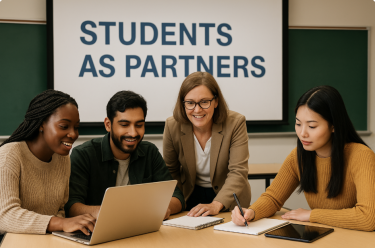
The Students as Partners program pairs an equity-minded undergraduate student with a faculty member who seeks to elevate their teaching and their students’ learning. Through this one-semester partnership, pairs collaborated to incorporate the student perspective into the design of a course, assignment, or project. Each pair determines when they meet and the expectations for each meeting. They also meet as a large cohort throughout the semester, where participants discuss a pedagogical approach to their partnership and share what they’ve accomplished through their collaboration.
This portfolio showcases a diverse range of projects with unique objectives and outcomes. The Students as Partners framework encourages each project to have its own personality, with the goal of the final product being more student-focused. If working with an undergraduate student is something that aligns with your teaching philosophy, please contact Jacie Moriyama
Students as Partners: Fall 2024 Projects at a Glance
*Note: This project was also produced in collaboration with the AI Literacy Ambassadors Program
Project Objective:
The goal of this project is to help students critically think about their AI use in college. We accomplished this goal by creating a 50-minute module to promote AI literacy among first-year biology students.
The learning objectives for the module are:
Explain the principles and mechanisms behind generative AI to a peer
Identify and evaluate the ethical considerations associated with the development and use of AI technologies
Analyze and differentiate between applications of AI that enhance learning and those that hinder the learning process, providing specific examples
Develop specific, effective AI prompts tailored for studying and tutoring tasks to optimize learning outcomes.
Project Benefits for Students:
Students will benefit from this module by gaining a better understanding of what AI is and how it works, as well as having open and unbiased discussions surrounding the use of AI in the classroom.
Project Assessment:
We will assess the project in the future by utilizing pre-class questions, in class clicker questions, and a post class AI learning plan.
Project Challenges:
One challenge was trying to locate an AI program that students could use specifically for biology course content. However, Notebook LM and Google Gemini are open to all students at CU. Additionally, finding information related to the environmental concerns of artificial intelligence was challenging because of the limited public data available from data centers and AI companies. We overcame this challenge by diving further into the academic research and by acknowledging that we are unable to confirm the accuracy of all of the statistics.
Project Leads:
- Anna Hoisington, Student as Pedagogical Consultant, CTL
- Christy Fillman, Teaching Professor of Distinction, Molecular Cellular & Developmental Biology
Project Artifact
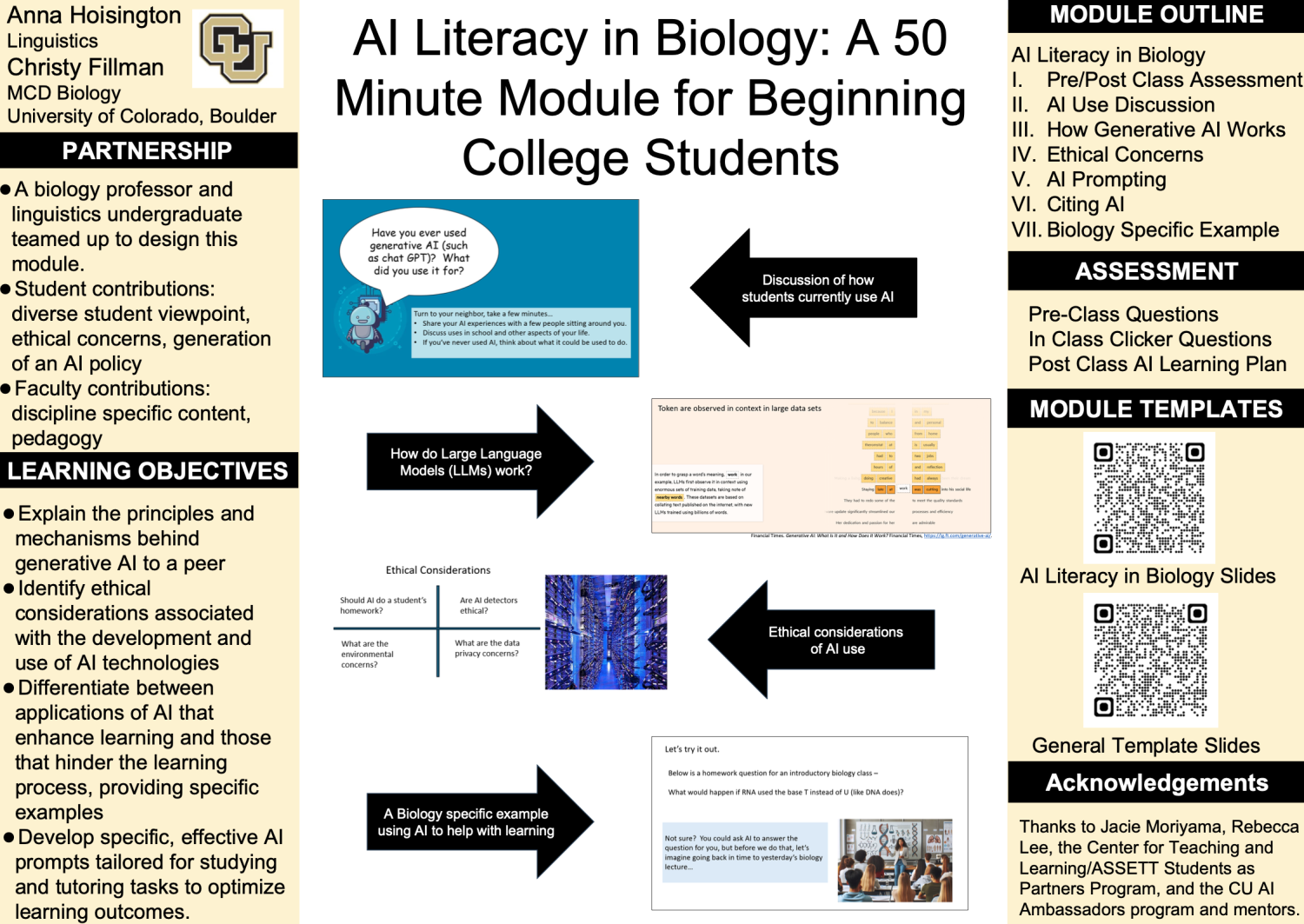
Project Objective:
The main objective focused on finding possibly free AI tools that could provide students with immediate feedback on their pronunciation. In the process of finding the AI tool, the Cengage representative visited the campus to promote a video assignment application called Bongo, integrated with their learning platform, MindTap. The original aspect of this integration is that students can receive a score and feedback on their video. In addition, we identified three AI tools (Language Reactor, Speechling, YouGlish) that [upper-division language learning] students were assigned to use on their second version of the video to see how effective and accurate these tools can provide feedback.
Project Benefits for Students:
In Fall 2025, French 3010 will be completely remodeled to allow students multiple attempts toward accuracy in pronunciation. Instead of the three syllabi the class is currently using, I am planning on seven sections, each one with a oral assessment focused more on the process than on the final product.
Project Assessment:
[Enrolled] Students had to answer two questionnaires: the first one about Bongo and the second one about the other AI tools. In addition, they also wrote a final paragraph in English to detail their experience throughout the process. Our conclusion was that students overwhelmingly enjoyed working with Bongo, as it provided them with general feedback on their video, even though it doesn't provide concrete phonetics feedback. They found the other tools to be unhelpful from this point of view.
Project Challenges:
The main challenge stemmed from the nature of our pursuit, as French phonetics is not among the mainstream AI tools. It has been challenging to find tools in the first place, and ultimately they proved to be ineffective. Bongo was an unexpected solution coming without cost to students and giving them overall solid feedback.
Project Leads:
- Anna Hoisington, Student as Pedagogical Consultant, CTL
- Alina Van Nelson, Associate Teaching Professor & 2nd Year French Language Coordinator, French
Project Artifact:
Project Objective:
The overall objective of the project was to improve the student experience in an online, asynchronous course by modifying five written assignments and the final project in the Clinical Nutrition course. The aim was to improve the assignment transparency, authenticity and relevance, inclusiveness, rigor, and student support. We began by thoroughly analyzing the original assignments and reviewing them for transparency, authenticity and relevance, inclusiveness, rigor, and student support. As part of this project, we learned about equity-minded assessment principles, took time to generate ideas, reviewed relevant literature, and regularly revisited the assignments, gradually making progress on each of them.
Project Benefits for Students:
Students may benefit in a numbers of ways. The hope is that they will have fewer questions about completing the assignments (transparency), appreciate the real-world nature of the assignments (authenticity and relevance), develop a new or further appreciation for different populations (inclusiveness), be challenged to a greater degree (rigor), and feel confident in completing the assignment (student support).
Project Assessment:
The class will be taught in fall 2025. At the end of the semester, the students will be polled about the assignments, asking about transparency, authenticity and relevance, inclusiveness, rigor, and student support. This feedback will be used in further improving the assignments for future semesters. Other nutrition course changes.
Project Challenges:
More than once we stalled on ideas for real-world examples to use in the assignments. There was not an easy answer to this other than to give ourselves time to think and come up with ideas both individually and in discussions together. We subscribed to the idea that there was no pressure for immediate solutions which allowed us to organically come up with ideas and answers.
Project Leads:
Grace Zinser, Student as Pedagogical Consultant, CTL
Nicole R. Stob, Assistant Teaching Professor, Integrative Physiology
Project Artifacts:
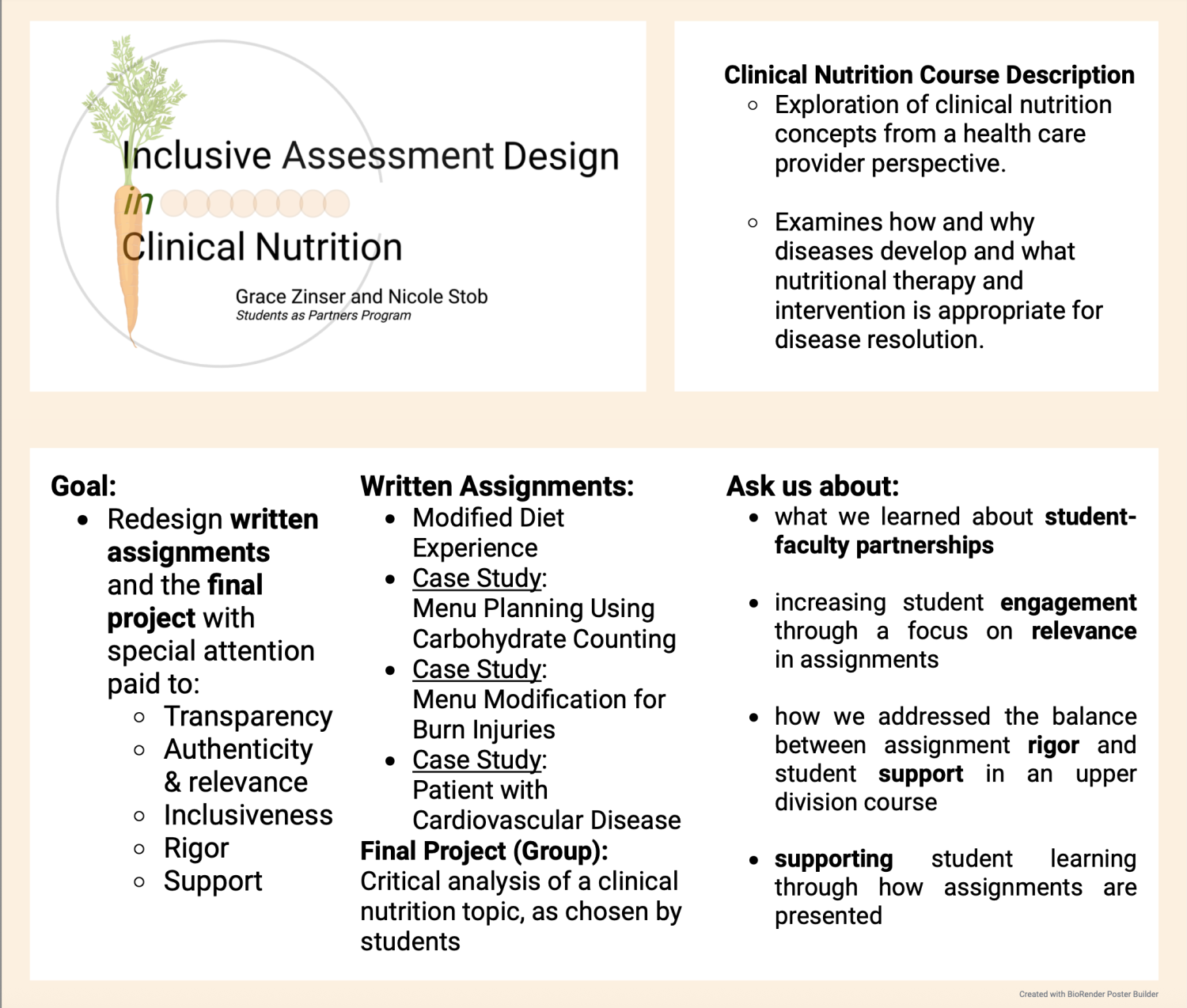
Project Objectives:
To convert a Course-based Undergraduate Education Research (CURE) course from an antibiotic drug discovery context into a cancer-related chemotherapeutic drug discovery course. To infuse evidence-based pedagogy into the course structure and design, utilizing an advanced student perspective as well as informally gathering feedback from students in the course and current TAs. The Student As Partners program allowed us to focus on what aspects of the current antibiotics course we have prioritized to change the most, and has allowed us to create the basic framework for which detailed summer transformations will take place. This a complicated project, and we have started to work on many aspects of it.
Project Benefits for Students:
They will better retain transferrable skills in a research context, as well as knowledge about cancer and human health that they can take with them in their careers and lives. We have streamlined the student experience to eliminate pain points and increase structure and communication.
Project Assessment:
In order to assess the outcomes of this project we will be measuring aspects of belonging, agency, and self-efficacy.
Project Challenges:
The biggest challenge is that this is a complex and involved endeavor. We worked to brainstorm, triage lists with ruthless prioritization, and make achievable gains as time allowed. We celebrated small wins, and regularly touched base to strategize and keep the project well-coordinated.
Project Leads:
Aris Wertin, Student as Pedagogical Consultant, CTL
Cheryl Pinzone, Teaching Assistant Professor, Molecular Cellular & Developmental Biology
Project Artifacts:
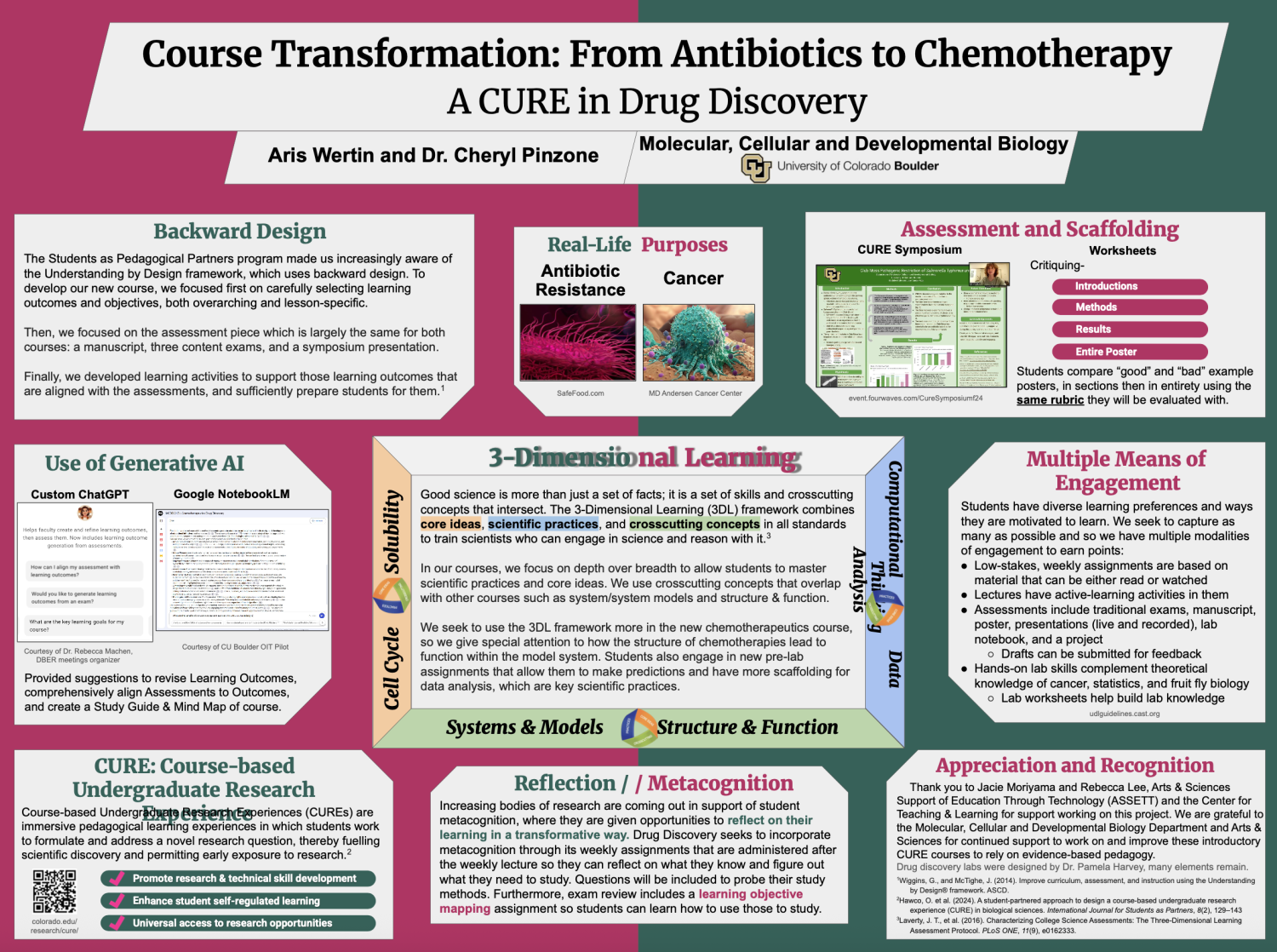
Project Objectives:
Design a course that helps students: Develop community with others in MASP, develop identity as a scholar, develop skills for talking about sensitive issues, and develop awareness of how internal models about the world inform how we make decisions. The Genes to Gender course will also support students to: differentiate gender and biological sex, describe variation in biological sex characteristics, identify factors that impact one's gender identity, and discuss how the use of binary and nonbinary definitions of sex and gender impact those with nonbinary and transgender identities.
We started working on course development in Fall 2024. Together, we met to create the outline of the course and develop the course's learning goals (both skills and content goals). From there, we each took topics that we were most passionate about and developed class plans, including finding relevant sources and creating student assignments. During our weekly meetings, we gave each other feedback on the class plans to help refine the course. Dr. Semsar filled in gaps and taught the course in Spring 2025. Adriana and Isaiah continued to help assess the course by summarizing exit tickets from each class period, conducting a course interview mid-way through the semester, and completing the final project to help refine assignment directions.
Project Benefits for Students:
Incorporating student perspectives in the course has had many benefits for students in the Genes to Gender course. From our collaboration on syllabus development, students have meaningful course topics and course assignments that students identify as helpful for their development as scholars. From our collaboration on class planning and course material acquisition, students have resources and assignments that are vetted to their level of background knowledge, a wide range of resources, and novel types of assignments. From our collaboration on assessment, the course is continuing to be adjusted to meet students where they are and help them develop a meaningful knowledge base that students see as important to their lives outside of the course.
Project Assessment:
- Exit tickets that had students list what was most memorable about the day's class.
- Summary assignments that had students identify two main theme of the course material.
- A course interview to determine what students felt like they were learning, what aspects of the course helped their learning, what aspects of the course hindered their learning, and what other topics students might want to learn in the class.
Project Challenges:
One of the biggest challenges was what to fit into a one-credit course. As we developed specific topics, we realized that some aspects of the course we had originally wanted would have to be removed. We regularly talked through what would need to be adjusted along the way, though that often meant having to cut things we had already worked hard on.
Project Leads:
- Adriana Espinoza, Student as Pedagogical Consultant, CTL
- Isaiah Fuentes, Student as Pedagogical Consultant, CTL
- Kate Semsar, Assistant Director of STEM Education & PEAC Director, Miramontes Arts & Sciences Program
Project Artifacts:
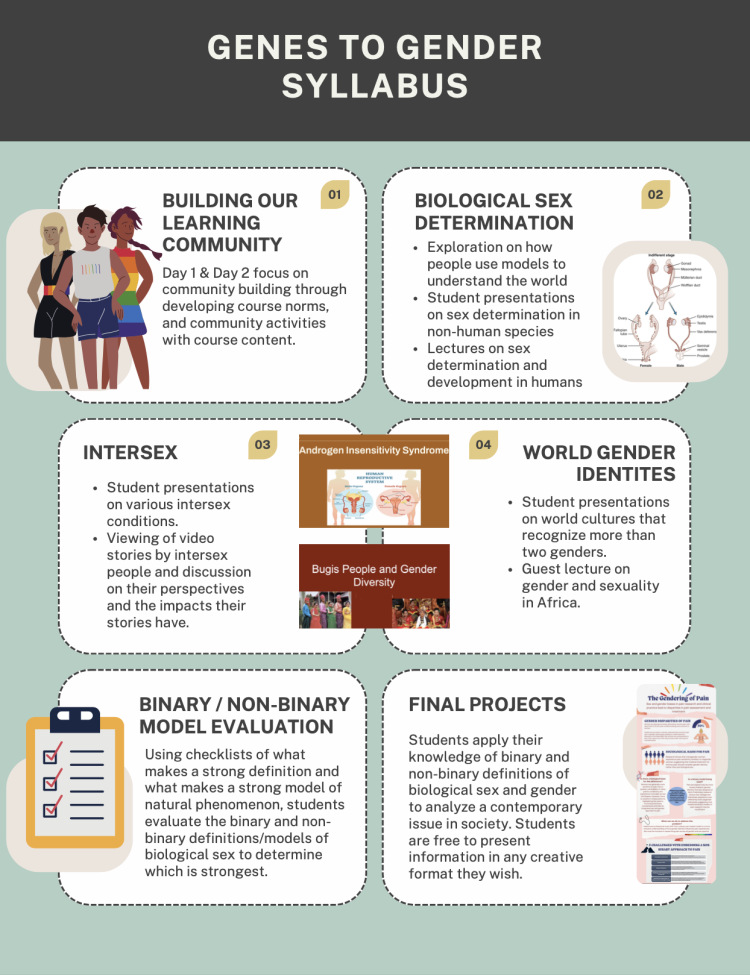
- Teaching Support Programs
- Faculty Learning & Collaboration Hub
- Teaching, Learning, and Technology Faculty Fellows
- Mental Health and Wellness Faculty Fellows
- Grade for Student Success Faculty Guide
- Fall Conference
- Fall Intensive
- Inclusive Community of Practice (ICoP)
- Innovating Large Courses Initiative (ILCI)
- Online Teaching Community of Practice (OCoP)
- Spring Conference
- Summer Design Studio 2025
- Data Science & Humanities Symposium
- Graduate Student Programs
- Student Programs
- Books & Podcasts for Educators
- Micro-Credentials
- Innovative Teaching Initiatives

